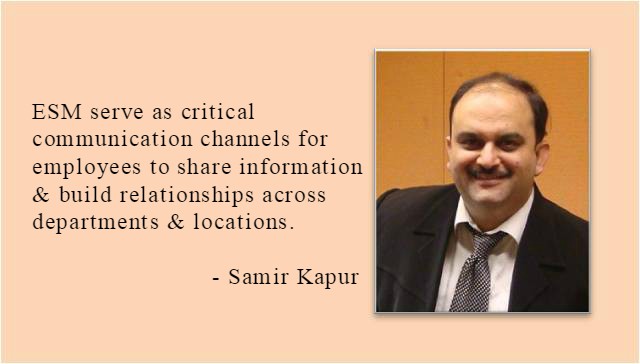Internal communications is a critical component to your company’s success. You need to think about the role of internal communications more strategically than ever before. Not just in the face of change events like acquisitions or a major marketshift, but also to align your employees behind your vision, your strategy, and to drive daily productivity. This only works if you can communicate effectively with them and excite them about their work. Reaching employees and engaging them will help you meet your goals, successfully.
Social media is becoming a critical enabler for effective communication.Your employees want to participate in conversations, relevant to their job role and workplace interests. Blanket communications through email or printed newsletters haven’t done much for employee engagement.What is more direct than your employee’s personal social media platforms? Social media communication improves success,engagement, and productivity across your organisation.
Social media for internal communications also referred to as Enterprise Social Media (ESM), serve as critical communication channels for employees to share information and build internal relationships across organisational departments and geographical locations.
Fact is – appearance of employees’ names, pictures and comments on ESM has drastically changed social interactions within organisations. The emergence of enterprise social media has thrown open multiple questions on how the adoption of internal social media contributes to increased multi-directional communication, workplace productivity, organisational collaboration, information sharing, employee engagement and decentralised organisational power structure. Public relations studies have examined ESM as an emerging trend in internal communication.
There are distinct roles and specified specific responsibilities associated with managing social media in PR. ESM can help socialise new employees, increase employees’ knowledge of an organisation’s culture and enhance affective commitment to their employers.
Like all new avenues/communication streams have a fight in an organisation as to which function owns it (case in point when social media started growing, the fight was between Marketing Department, Corporate communications and Customer Care Department). Key questions remain to be answered in the emergence. For instance, which department(s) oversee(s) the ESM function within an organisation? How does ESM management work with other organisational functions to accomplish organisational goals? How can an organisation best manage its internal social media to achieve employee engagement in ESM? How does an organisation expect its employees to use ESM in conjunction with external platforms to communicate on behalf of their employers?
ESM is influenced by organisational culture and management style. Cultivating a trusting, supportive organisational environment is essential to encourage employee participation in ESM. It is important for employees to understand why and how they can get involved. An unsupportive organisational culture gives rise to disengaged employees and organisational silos. One can’t undermine the commitment of Top management’s direct involvement is correlated with successful ESM management and high employee morale.
One of the key challenges of managing ESM communication is that it is perceived as “not work related”; the informal nature of ESM communication may be misunderstood by employees; “self-censorship”; and “not-in-action” top management’s support to ESM management.
After going through the best communication practices followed by some companies that are in “the best places to work for” list, shows that many are using ESM to communicate with their employees. The ESM function of these organisations have an integrated organisational function such as marketing and corporate communications. ESM was managed at the same level as other primary communication functions, such as internal communication, media relations and financial communication/investor relations.
Having a senior executive from marketing or corporate communication to oversee ESM seems to be one of the best ways to achieve Integrated Marketing Communications goals and reduce functional silos to the best organisations can. The ESM platforms focus on coordinating all internal communication messages and ensure consistency across platforms. At the same time, ESM involves cross-functional coordination and collaboration with marketing, internal communication, advertising and other departments. Key takeaway – ESM should report to a senior communication executive (i.e. a CCO or CMO, or a VP of communication or marketing) and be managed at the same level as other communication-related organizational functions.
While the practice followed by some companies are encouraging and positive, however there are functional silos that still exist. In many organisations, ESM still reports to marketing communication or corporate communication, and the strategy side of the social very often “lives on the marketing side.” The importance of keeping employees informed about organisational happenings via ESM and motivating them to become their employers’ ambassadors on external social media platforms. This is how the integration between internal and external communication should take place—organisational messaging must be consistent across all internal and external channels. Self-censorship did prevent some employees from actively communicating on both internal and external social media platforms. Key takeaway – The key components of ESM that are integral to an organisation’s IMC programs are two-fold: (1) consistent messaging across platforms and (2) an organisational function in true collaboration with other functions to coordinate an organisation’s communication efforts.
Cultivating a nurturing, supportive organisational culture may boost employee engagement. Employees’ identification and internalisation of the organisations’ values fundamentally guides their communicative action on social media. Social media training definitely should be in place to keep employees knowledgeable about their organisations’ social media policies and regulations. We at Adfactors are proud of the fact that all of our client-facing employees are trained in social media from a well-recognised international university. Key takeaway – Social media training is a must. Both orientation and ongoing training programs are essential. Key barriers identified to the adoption of ESM are the type of industry, funding, leadership support amongst others.
Employees should become active brand ambassadors on both internal and external social media—integrating internal and external social media and filling any existing information gaps for their employers.



ESM, while seems new, has been around for ages. Yammer was launched way back in order to let this happen. Over the years, ESM has matured a lot. The sheer launch of Facebook @ Work, is the showcase of how ESM is moving. That also helps in getting everyone on board and not fighting for control Fb@W allows different groups to work independently, making them comfortable with the channel and then having the Corp Comm team drive the broader communication.
Earlier this used to be done through groups, but a dedicated app is a great way to go about it.